Weddings in China
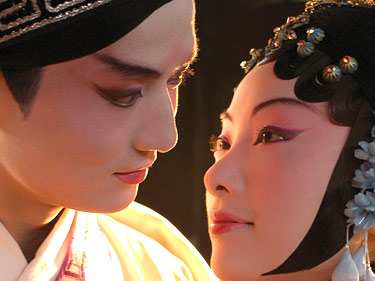
www.international.ucla.edu/asia/print.asp?parentid=47941
The most recent Chinese wedding which I attended was in UCLA’s Royce Hall in September 2006. It was a theatrical adaptation of the famous opera" Peony Pavilion," written by Tang Xianzu and adapted by Kenneth Pai, a modern Taiwanese writer. The cast looked youthful to me, and indeed they were, for they were university students from all over China who had performed the operatsixty times in China, Hong Kong and Taiwan before coming to America to perform in university auditoriums.
My Masterpieces of Asian Literature class in the spring semester 2006, taught with Dr. Anne Cavender, had read the Peony Pavilion, so I was quite happy to go to the UCLA production. Seeing the wedding seemed to offer a useful connection to the research for this “annotated album.”
The wedding takes place in the very last scene by order of the emperor, both the UCLA production and in the literary masterpiece. An improbable betrothal had taken place between the lovers much earlier when the bride whose name in the play/opera was “Bridal” who had died, came back as a ghost and met her intended groom “Liu” near her burial place. (Scene 28 in Tang Xianzu).
About half the story took place between betrothal and wedding, for first “Bridal” has to be brought back to life, and “Liu” has to pass his exams as a good Chinese Mandarin must do. He scores so high on the exams that he is brought to the court of the emperor, where at first “Bridal’s” father rejects him as unsuitable for his daughter.
This wedding was memorable because of the excellence of the production and for the powerful attraction between bride and groom that drew her back into life from her grave. I was also happy for I could return from the Ming Dynasty Period where I had watched this wedding with rapt attention for three hours, and climb into a waiting bus to go back to Redlands; thereby I did not have to wait until my space vehicle appeared, for it was taking someone else to an ancient wedding that night.
Each time I have gone to China or Taiwan, I have been a "wedding crasher." Mainly it seems to happen in hotels where there is a wedding party eating at a huge table, but often seated near our party. I wondered if the wedding party must wish to be seen and photographed by crashers like myself, or perhaps it is because the restaurant owners wish to have my group of Western tourists get to feel the positive energy from a wedding. In any case, I think the picture below shows the strong Western influences upon the wedding attire of both Chinese bride and groom.
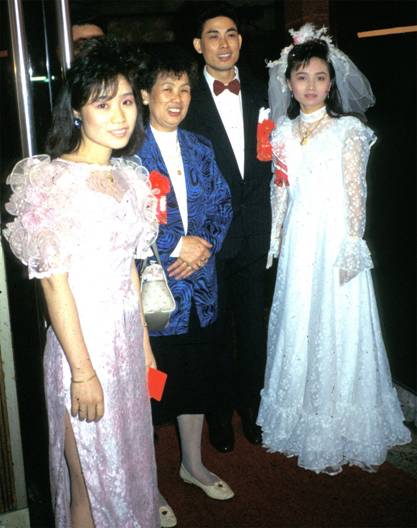
Note in this wedding pose the maid of honor has an off color pink and the mother of the groom has a deep blue dress.
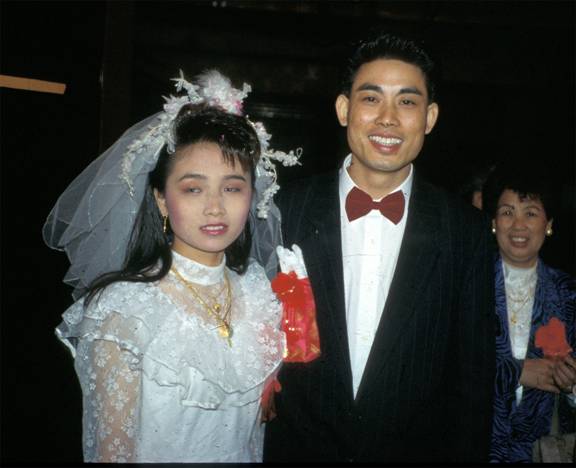
Moving closer, I shot a “close up” of the bride and groom. The poor bride is beginning to look a little tired with all these pictures…or might she be thinking of what is to follow in her life?
In Taiwan many stores have dresses for bridal parties. In this particular store, my daughter Heather and I were surprised to find that the women shopping there were not Chinese at all, but these were young Japanese girls coming for their dresses.
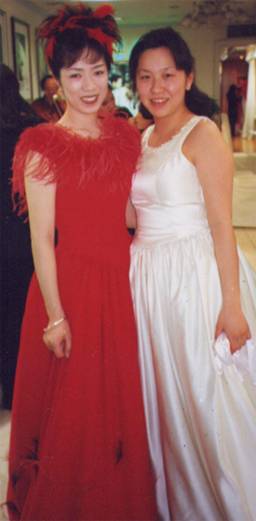
How did we know they were Japanese? Answer: They spoke Japanese to us, and they did not know any Mandarin!
Is it a Chinese wedding if it is America? I think so especially if the bride’s family is Chinese, then I have had the experience of a fantastic dinner at the feast after the ceremony. Here at the wedding reception of Celeste Law in Monterey Park had the most food I have ever seen at any wedding, or indeed any meal my whole life.
.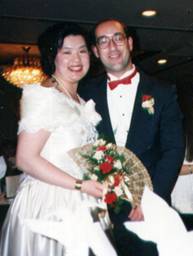
I first came to know Celeste when she appeared in my office for an interview for the Proudian honors program. She later signed up for my first course in Asian Religions which took us to Hawaii, Japan and Hong Kong in January l990. Here her smiling face appears as a central figure in our class picture at Chung Chi College in Hong Kong

Celeste had such a positive mood every day in the month, thereby greatly pleasing me and the rest of the class. Looking at this picture in 2007, I became aware two others who met in that class were later married Doreen Hui, from Singapore and Lionel Etriaard, from France. Was it the magic of Hong Kong in the New Year Celebration that gave them the idea?
Here in the San Bernardino Presbyterian Church is depicted a moment of exchange of rings between Steven Morse and Lihong An.
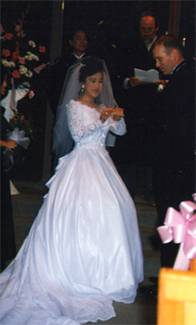
Lihong An had been born in Sian Province, China, and there she met Steven while he was temporarily assigned as an aircraft engineer. Later she came to California at the invitation of Dr. Eugene Ching, Visiting Professor of Chinese Language, University of Redlands, who had known her grandmother.
For the sake of the Chinese speaking guests at the wedding, the Rev. Caleb Wu translated my English comments into Chinese. I was surprised that the also translated my attempts to say something in Chinese,
translated into Chinese, as well.
The huge collection of presents which were brought to the church served to show the generosity of the many Chinese speaking people who had come to know and love Lihong during her brief residence. There was only one small problem! The couple did not find time or know they had to the San Bernardino County office to start the official process, so on the day of this picture, the marriage was not to be recorded. Some months later they came back to my office in July with the intent of going back to the church, getting the original people who came to the wedding and re-doing the ceremony or parts of it.
But, alas, by then Dr. Ching had gone to China himself and who knows how difficult it would have been to find anyone at the first wedding. So, with the bride now about 7 months pregnant, I decided to have the ceremony in my small office. I went down the hall and found two witnesses in the School of Education, Mrs. Linda Hunt and Dr. Bud Watson to sign the license. They were quite surprised, but both agreed. I made a short wedding speech recalling that we had done this “before God and witnesses” in San Bernardino some months earlier, had them re-state their vows, and pronounced them “husband and wife, in accord with the laws of the State of California.” The second time around theirs was the briefest wedding I have ever conducted.
On March 3, 2007 I received from Susan Sordon the following report :
===============================================
Source: http://www.chinadaily.com.cn/china/2007-03/04/content_819126.htm
China's newly-weds spend 125,000 yuan
(Xinhua)
Updated: 2007-03-04 17:06
China's marriage-related industries like wedding photography and wedding ceremony
services pluck an average of 125,000 yuan (about 16,000 U.S. dollars) from the pockets of
each newly-wed couple or their parents, more than the couple make in a year, reported
Sunday's Beijing Morning Post citing a recent survey of the country's marriage-related
industries.
An analysis of nearly 60,000 couples showed that more than 70 percent of the spending goes
on durables such as furniture and home appliances.
The wedding itself -- the ceremony, photography, wedding gowns, the honeymoon and
jewelry -- accounted for less than 20,000 yuan, 15.5 percent of the total, and analysts claim
there is room for growth there.
The wedding feast accounted for the rest of the spending.
According to the survey, overall marriage spending reached a whopping 557,478 yuan
because it often includes the purchase of an apartment and a car. Chinese people tend to
regard an apartment as indispensable for starting a family while autos have become
affordable for many and are a key status symbol.
The sums involved are huge for newly-weds, as 86 percent of those interviewed earn less
than 8,000 yuan a month.
47 percent of the newly-weds interviewed admitted that 20-60 percent of the marriage-related
spending came from their parents, while a minority of 14 percent relied on their parents to
stump up 80-100 percent of the dosh.
The survey also showed that newly-weds in Shanghai and eastern China tend to spend more
on decorating their apartments, while Beijingers and other northerners prefer to shell out on
wedding photography, wedding feasts and honeymoons.
About 10 million couples get hitched in China each year, generating 250 billion yuan of
marriage-related spending.
Adrian (2003) captured tensions between traditional values in Taiwan in wedding ceremonies.
She wrote that old-fashioned betrothal and wedding ceremonies can still take place in private homes.
But most public weddings have been "globalized" with components from many sources:
"(1). The attire has origns in Victorian England.
(2). The couple walks down a red-carpted aisle to Mendelssonhn's ubiquitious "wedding march."
(3). Guests come armed with firecrackersin tiny plastic 'champagne' bottles" (111). |